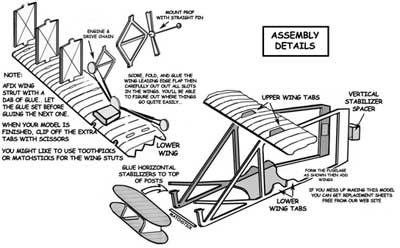



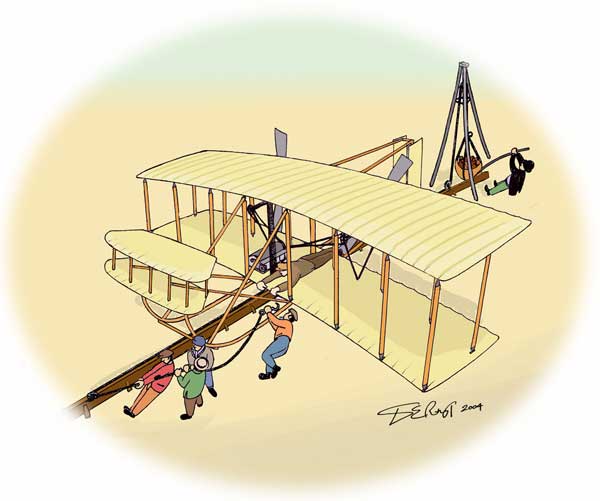
This original artwork by Derek Roberts is available in much higher quality (suitable for framing), on the Full Collection DVD.
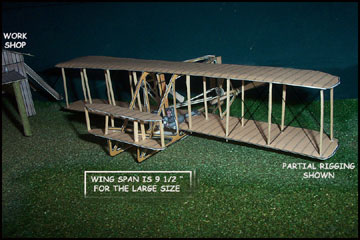
When the Wrights took their 'Flyer' to Kill Devil sand hills, near Kitty Hawk, North Carolina. in October,1903. they spent the early part of that month brushing up their flying on the No. 3 glider. Only when they learned of the first unsuccessful Langley test did they realize that they might be beaten into the air.
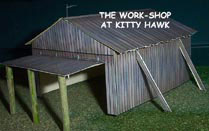 Before all was ready for the first test of the 'Flyer', Langley
had tried again and failed. The Wrights were no more fortunate
on December 14, when Wilbur moved the elevator too soon, half-lifted
off the launch track and slammed back into the ground.
Before all was ready for the first test of the 'Flyer', Langley
had tried again and failed. The Wrights were no more fortunate
on December 14, when Wilbur moved the elevator too soon, half-lifted
off the launch track and slammed back into the ground.
It was Orville's turn next and at 10:35 a.m. on December 17, 1903, he made the first 12-second flight in the 'Flyer', covering 120 feet. At long last, man had grown wings.
What people say...
The DVDs arrived today. I should be working outside, but I couldn't wait. While searching I ran across the Wright 1909 engine. It is especially interesting as I have a partial wingrib from the 1909 (or 1910) Wright airplane. I have planned a wall display using the rib parts with an old Renwal plastic model I have saved. The engine will make a nice touch. Thanks, Bob Newton
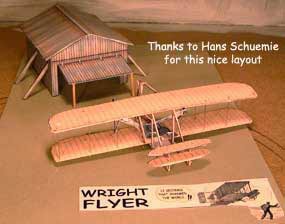 Just finished the small version of the Wright Flyer.
It looks fantastic! This is the best yet , It looks perfect
hanging in the center of the ceiling of my hobby room, surrounded
by the hundred or so other paper planes I've built since
discovering this hobby two years ago. Seventy or so are
FG models, the rest from other sources. I prefer FG models,
as I can build them in a day or two, and the techniques
are similar. A lot of the others are difficult to align
and shape properly. Your's always go together smoothly. Thanks for providing an excellent product. Rob
Just finished the small version of the Wright Flyer.
It looks fantastic! This is the best yet , It looks perfect
hanging in the center of the ceiling of my hobby room, surrounded
by the hundred or so other paper planes I've built since
discovering this hobby two years ago. Seventy or so are
FG models, the rest from other sources. I prefer FG models,
as I can build them in a day or two, and the techniques
are similar. A lot of the others are difficult to align
and shape properly. Your's always go together smoothly. Thanks for providing an excellent product. Rob
The Wright Flyer went very well-built the large version that same day and now have it on display. Charles Bond (1/03)
The Wright Brothers Kitty Hawk Flyer
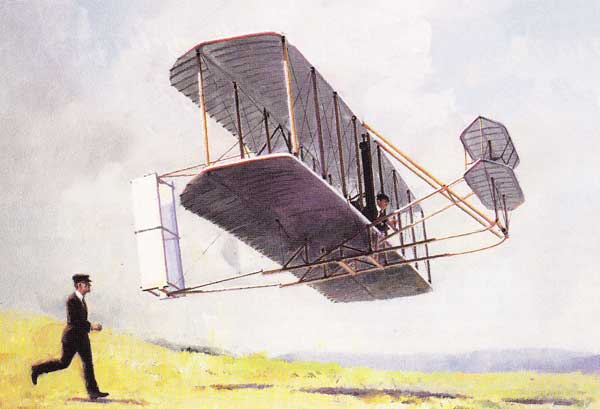
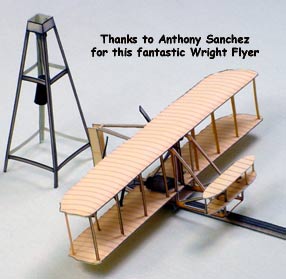 |
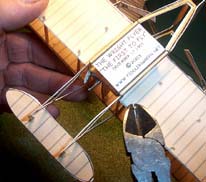 A few photos to help you build the Wright Brother's Flyer |
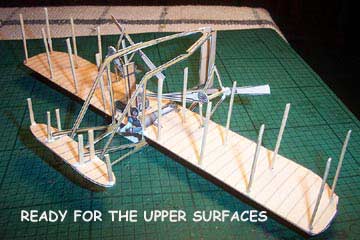 |
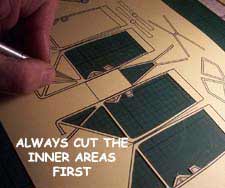 |
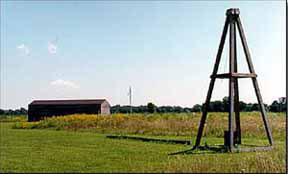 |
 |
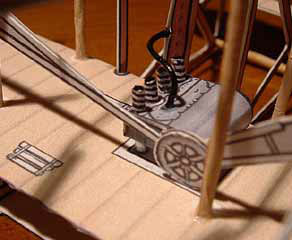 |
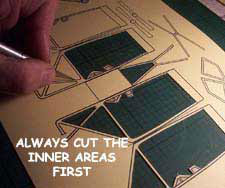 |
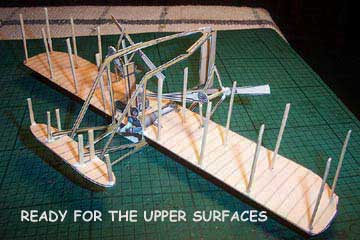 |
 |
 |
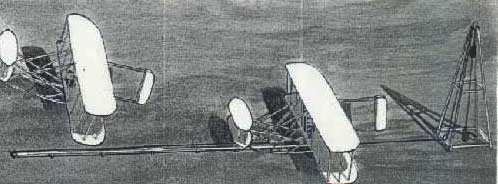 |
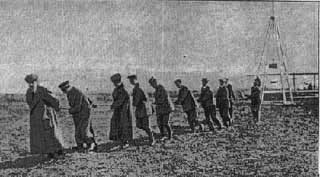 |
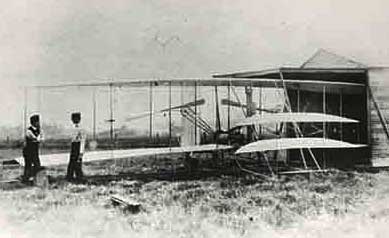 |
In 2003, the world celebrated the 100th anniversary
of the first flight of an airplane by the Wright brothers
at Kitty Hawk, North Carolina. While much attention will
be paid to the events of December 17,1903, it is important
to note that the four flights of that day were only one
small step in the development of the airplane. The brothers
had already invested three years of work between 1900
and 1902 perfecting unpowered gliders and learning to
fly. It would take another three years work, from 1903
to 1905, until all the problems of their powered airplane
were solved.
Between 1903 and 1905, the brothers built a series of
aircraft which would eventually lead to the first practical
airplane. In early 1903, the Wrights could not find an
engine manufacturer who would meet their requirements
for both light weight and high horsepower. So, in a period
of just six weeks, they built their own 4 cylinder, 12
horsepower, internal combustion engine. They also designed
and built highly efficient aircraft propellers using their
wind tunnel results and realizing that they must be shaped
as a rotating airfoil.
In September of 1903, they returned to Kitty Hawk with their
new aircraft. The aircraft was similar to the 1902 craft
with twin wings, twin rudders, and canard elevators. The
wing span was now 40 feet long, with a six foot chord and
five feet between the wings. The plane also carried twin
counter-rotating pusher propellers connected by bicycle
chains to the 12 horsepower motor. The pilot would lie beside
the motor on the lower wing. With the pilot and the motor,
the new aircraft weighed about 700 pounds. After a number
of frustrating problems with the propeller shafts and transmission
sprockets, they finally made four successful flights on
December 17, ranging from a little over 100 feet to over
800 feet. Each of the flights was marked by an instability
in pitch: the nose, and consequently the entire aircraft,
would slowly bounce up and down. On the last flight, hard
contact with the ground broke the front elevator support
and ended the season's flying.
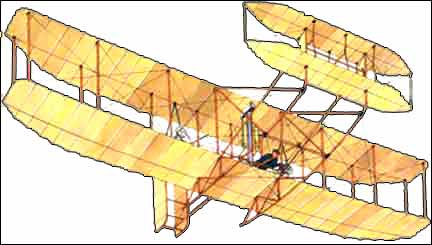 Returning to Dayton, the brothers began work on the 1904
aircraft. They built a new engine similar to the 1903 engine
but they increased the power to 18 horse power by slightly
increasing the bore (diameter of the piston) of the engine.
They also built a new airframe which was very similar to
the 1903 aircraft in size but with redesigned rudders. The
new aircraft was flown from a cow pasture owned by Torrence
Huffman and located just outside Dayton.
Returning to Dayton, the brothers began work on the 1904
aircraft. They built a new engine similar to the 1903 engine
but they increased the power to 18 horse power by slightly
increasing the bore (diameter of the piston) of the engine.
They also built a new airframe which was very similar to
the 1903 aircraft in size but with redesigned rudders. The
new aircraft was flown from a cow pasture owned by Torrence
Huffman and located just outside Dayton.
Without the winds of Kitty Hawk, it was a problem getting enough airspeed to fly. So, in 1904 the brothers devised a catapult system to help launch the aircraft. Once airborne, the aircraft experienced the same pitch problems as the 1903 aircraft. In an effort to solve the problem, they moved radiator and fuel tank from the front struts to the rear struts and moved the engine slightly aft to move the aircraft center of gravity aft. But this only made the pitch problem worse.
So the brothers added 200 pounds of ballast to the front elevator to move the center of gravity farther forward. The weight of the aircraft then increased to about 900 pounds with the pilot. The ballast improved the handling of the aircraft and Wilbur was able to complete the first circuit of the airfield on September 20, 1904. By the end of the year, the plane could complete four circuits and stay in the air for five minutes, but the aircraft still had major handling problems and was overweight.
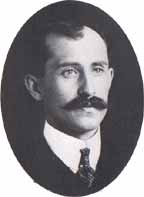
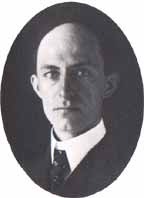
The brothers were finally able to solve the pitch problem by increasing the size of the elevator and rudder and moving the elevator and rudder farther from the center of gravity on the new 1905 aircraft. This increased the torque produced by the control surface and provided greater control for the aircraft. The overall length of the aircraft increased from 18 feet to 28 feet. The radiator and fuel tank were moved back to the front strut and the size of the fuel tank was increased. The engine stayed the same as the 1904 aircraft and the ballast was discarded, reducing the weight to nearly the same as the 1903 aircraft. The 1905 aircraft could be flown until the fuel tank was empty; staying in the air for more than a half hour, flying nearly 25 miles around Huffman's farm, executing turns and figure 8's, and flying more than 50 feet off the ground.
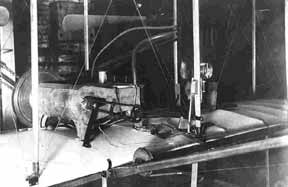 After six years of work, the brothers finally had a practical
working airplane and began to market it to the War Department. In 1902 the brothers,
by then highly proficient in handling a glider, had built
their third one. Its construction was based on the results
of their own wind tunnel measurements, the accuracy of
which convinced them that they were ready to build a machine
equipped with an engine.
After six years of work, the brothers finally had a practical
working airplane and began to market it to the War Department. In 1902 the brothers,
by then highly proficient in handling a glider, had built
their third one. Its construction was based on the results
of their own wind tunnel measurements, the accuracy of
which convinced them that they were ready to build a machine
equipped with an engine.
The first powered Wright plane was a biplane with a wingspan of 40 feet, 4 inches, length of 21 feet, and height of 8 feet; it weighed 605 pounds. The wings were constructed of spars and ribs covered on top and bottom with unbleached and untreated muslin cut on the bias. The outer wing extremities could be warped for lateral balance.
Behind the wings were two propellers which rotated in opposite directions. They were made of two layers of spruce glued together, each layer one and three-quarters inches thick. The ribs and undercarriage were of second growth ash and the spars and struts were of spruce. In front, mounted on outriggers, was the elevator with 48 square feet of fabric surfaces, movable for vertical steering. In the rear was a rudder with a fabric area of 20 square feet. The whole was mounted on a pair of skids which formed the landing gear. The pilot, who lay prone on the lower wing, operated the front elevator by rocking a small lever with his left hand; he controlled the warping of the wings and rudder, which were interconnected, by moving his body from side to side so as to shift the control cradle on which his hips lay.
His position on
the lower wing slightly left of center balanced the weight
of the engine which was fastened to the wing beams. It
was impossible to get an engine from American manufacturers,
so the Wrights, who had built an engine to power their
tool shop, in six weeks constructed one of their own.
They were aided in this project by Charles E. Taylor,
a machinist in their employ. Their joint efforts produced
a 4cylinder engine with a 4-inch bore and stroke developing
nearly 12 horsepower.
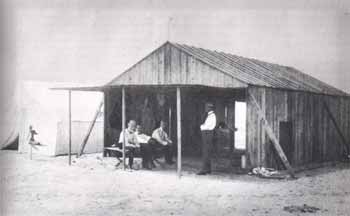
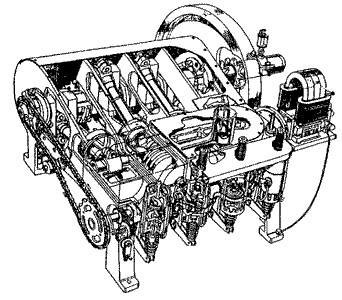 The airframe and engine were shipped to Kitty Hawk in
September 1903. There were delays and difficulties with
the equipment, but on 14 December everything was ready
for a test flight. The plane, facing into the wind, was
mounted on a dolly, which rode on the 60-foot launching
track laid out on level ground. On the toss of a coin
Wilbur Wright won the first chance to pilot the plane.
It rose from the track but turned up at too great an angle,
stalled, and fell, breaking a skid and other small parts,
but leaving Wilbur unhurt.
The airframe and engine were shipped to Kitty Hawk in
September 1903. There were delays and difficulties with
the equipment, but on 14 December everything was ready
for a test flight. The plane, facing into the wind, was
mounted on a dolly, which rode on the 60-foot launching
track laid out on level ground. On the toss of a coin
Wilbur Wright won the first chance to pilot the plane.
It rose from the track but turned up at too great an angle,
stalled, and fell, breaking a skid and other small parts,
but leaving Wilbur unhurt.
Repairs were quickly made, and on 17 December, a cold and windy day, another try was made, this time with Orville Wright at the controls. After traveling 40 feet, with Wilbur running alongside to steady the end of one wing, the plane rose from the ground and traveled 120 feet against a 22-27-mile-perhour wind; it had remained in the air for 12 seconds. Thus Orville Wright was the first man to achieve flight in a power-driven heavier-than air machine. The brothers took turns piloting the plane, and on the fourth and last flight of the day Wilbur had the plane in the air for 59 seconds, covering a distance of 852 feet.
A rough landing broke the skids and braces of the front elevator and while the brothers were standing nearby discussing the flight, a sudden strong gust of wind upset the plane, turning it over several times and damaging it so extensively that immediate repairs could not be made. The brothers sent a telegram from Kitty Hawk to their father, Bishop Milton Wright, telling him of their success and asking him to inform the press. Flights were discontinued at Kitty Hawk and the damaged machine was shipped back to Dayton.
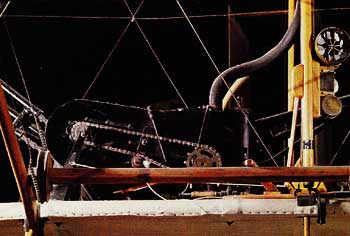 |
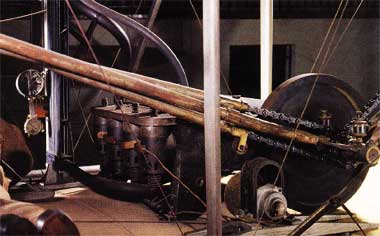 |
Orville and Wilbur Wright designed their own lightweight motors. Hand-built by their "mechanician" Charlie Taylor, these engines were crafted with basic machine tools. This engine is on display with the 1903 Flyer at the NASM. |
The engine seen from the rear on th 1905 Flyer III in Dayton. The four cast-iron cylinders are visble as well as the flywheel, the chain drive system for transferring the power to the propellers and the magneto. |
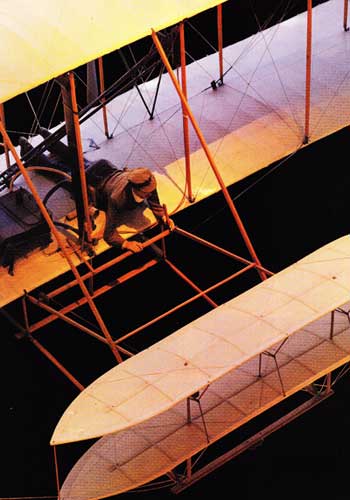 |
The NASM's Wright Brothers 1903 Flyer seen from above-the seagulls' view on December 17, 1903. |
Specifications for the Wright Flyer
 |
Length: 21 ft 1 in Wingspan: 40 ft 4 in Height: 9 ft Wing area: 510 ft² Empty weight: 605 lb Max takeoff weight: 745 lb Powerplant: 1× straight-4 water-cooled piston engine, 12 hp Performance Maximum speed: 30 mph Service ceiling: 30ft Wing loading: 1.4 lb/ft² Power/mass: 0.02 hp/lb |



